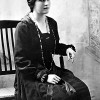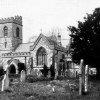Ask any Dorset native to name their two most pre-eminent literary figures and most likely they would reply: “Thomas Hardy and William Barnes.” Less well known however is another William who seems to have slipped into the position of becoming the County’s forgotten third poet: William Holloway.
Holloway was born at Whatcombe, a manor in the parish of Winterborne Whitchurch about four miles from Blandford, presumably early in 1761 as there is a record of his baptism at Whitchurch on June 23rd of that year. William was the last child of Lawrence and Frances Kains Holloway, whose other children were another son, Thomas and a daughter, Elizabeth. His great-uncle, also called William, was serving as Whitchurch’s Churchwarden at the time of the poet’s birth.
Few details of William Holloway’s earliest years were recorded, other than that he was orphaned in early childhood, his father dying before William was two years old. Following the death of his mother not many years after, William was adopted by his grandmother. His years at school however, were happy ones, during which time he acquired some grounding in Greek and French, and came to admire and inwardly digest the works of Milton, Gray, Shakespeare and James Thompson.
While still a young man, William Holloway left his grandmother’s home and care to settle in Weymouth. He took up an apprenticeship with a local printer, eventually being put in charge of the printing shop attached to Weymouth’s Circulating and Musical Library owned by the obese larger-than-life public figure of John Love. It is thought that from an early age William had already begun to write verse, though his first published work, a eulogy on the local Halsewell shipwreck disaster, did not appear until 1788, when he would have been about 37. A small book of verse under the title of The Cottager appeared the following year, these early works being published by his employer John Love.
On November 1st in the year before his poem about the Halsewell was published, Holloway married a spinster of Melcombe Regis, Christian Jackson, at St. Mary’s Church in that parish. They had four children, all girls: Elizabeth, Lucy, Mary and Hannah, of which only Elizabeth appears never to have married. By this time Holloway had matured into a tall, dark quite handsome man. A contemporary print shows him as having a long swarthy face, dark eyes and a pronounced aquiline nose.
In 1798 George III and his entourage paid their first visit to Weymouth, an occasion which spurred Holloway and several local amateur poets to contribute odes on the event to the Salisbury-based Western Country Magazine. During 1790 and 1791 Holloway contributed five of the descriptive verses for twelve Weymouth views, originally published by Love in collaboration with the engraver James Fittler but subsequently collected together and re-issued as a single volume.
By 1792 The Halsewell and The Cottager had been sufficiently well received by the public to cover Holloway’s expenses, such that Love could proceed with publishing The Fate of Glencoe, a historical ballad. In his preface to this work Holloway exemplified much of the half-veiled modesty that characterised this unprepossessing bard throughout his life. He made it plain that the work was penned amid “the hurry of business” and “interruptions of active life.” Though essentially a studious and serious thinker, Holloway also relished the dramatic arts and theatrical life, once composing a short epilogue for a play staged at Weymouth’s Theatre Royal as well as the lyrics for a song to open a new theatre at Dartmouth.
But in October 1793 Love suddenly died, pitching his respectable partner Holloway into one of those dramatic life-course shifts that so many people experience. Under probate Love’s business stock went up for sale and in his will Holloway inherited his printing equipment and materials for a fee of ten guineas a year, in effect inheriting his employer’s works and library. But for various reasons Holloway was not able to avail himself of this opportunity for proprietorship. Instead he then entered upon a phase of his life which he was later to recall as a time “when fortune frowned.”
In an attempt to break free of what he felt had become a professional blind alley Holloway threw up his Weymouth associations and moved with his wife and daughters to Leadenhall Street in London. In June 1798 he landed a job as a clerk at the office of the East India Company in the same street. His position was well-paid and to all accounts not burdensome, since the clerks had privileges such as free breakfasts and postage as well as enough spare time to read papers. But it is likely that Holloway owed his position to Weymouth’s Steward family, who had close associations with the EIC, and Holloway did dedicate two poems to Francis Steward, a former mayor of the town.
Over the 33 years Holloway was in the service of the EIC the greater part and culmination of his poetry was written. Thematically he was soon reverting to nostalgic elegies on his native county such as The Rustic Farewell: a Fragment in the Dorset Dialect; The Peasants Fate (reprinted four times) and Scenes of Youth. Years later he entered into partnership with another poet, John Branch, to produce a small four-volume work on natural history.
Holloway honourably retired from the EIC at the age of 60 in 1821, though it was another ten years before the company would grant him a pension. The poet did not, as might have been expected, retire to Dorset, but to Hackney, then just a village about three miles from Leadenhall Street. Personally and domestically he was cared for by his eldest daughter Elizabeth, his wife Christian having died some years before. Holloway’s other three daughters all married London men and settled in the capital. Rock Place, his home on Tottenham Road in the Hackney hamlet of Kingsland was even then becoming enclosed by the town-house developments that would eventually absorb the village into the greater metropolis. But when he moved in, Holloway could still look back towards the fringes of London across fields of waving corn.
In 1852 Holloway had to undergo the intense emotional pain of watching his beloved Elizabeth descending into an early grave, even as he himself had begun inevitable decline. After his own end came on July 21st 1854, Holloway was buried in Stoke Newington Cemetery beneath a memorial stone mistakenly inscribed with his age as 96 instead of 93, though today almost illegible from erosion. In his will Holloway left £100 to be shared out between his surviving daughters and grandchildren. Although his obituary in The Times acknowledged his work at East India House, it did not commend, or even name a single one of his volumes of verse.
And perhaps it is this, added to the fact of his early departure from his home county that explains why William Holloway was fated to become a forgotten poet. It has been Holloway the print-shop manager and mercantile clerk the press and public had remembered – not Holloway the author of a considerable literary output. But through his poems he has kept alive such poignant vignettes of rural life in Regency and Victorian Dorset: its hay-making, dairying, crafts, maypole dancing, village weddings; the schoolboys fishing a stream or truanting to watch the village blacksmith.
Besides the aforementioned, Holloway’s other anthologies are Poems on Various Occasions (1798); The Baron of Lauderbrook (1800); The Chimney Sweepers Complaint (1806); The Minor Minstrel (1808) and the Country Pastor (1812).



